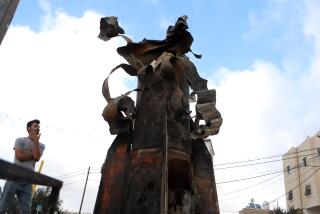In for Long Haul, Despite Minefields : If We Forgo All Risk, We Can Forget Being a Lever in the Gulf
- Share via
For many Americans, the sight of U.S. combat ships steaming to Kuwait behind the tanker that they were supposed to be escorting was one more dismal link in a chain of events that extends back to the U.S. defeat in Vietnam. For many of America’s friends, the sight was another sign of American weakness and a new reason to fear a lack, or a withdrawal, of U.S. commitment.
The obvious question was how the United States could have failed to anticipate a mine attack when the Iranians had been using such weapons for months--including against a Soviet tanker.
One answer is that the United States did anticipate the risk. Long before the U.S. re-registration of some Kuwaiti tankers, U.S. military planners identified mines as one of the two greatest risks that the convoys faced--and said this in classified briefings to Congress. Long before the Bridgeton was hit, Washington recognized that it needed mine-warfare support from European allies. It wanted the small Saudi mine fleet to be more active. And it wanted Kuwait to allow U.S. minesweeping helicopters into that nation.
Washington sought this support, but did not get it. France and Britain both increased their presence in the Persian Gulf. But both were afraid that joint action could become a major domestic political issue and possibly lead to pressure to reduce their presence. Other European nations were afraid of taking sides or losing trade with Iran.
Kuwait and Saudi Arabia felt that they already were taking serious political risk. Kuwait is having to quietly purge many Shia Muslims from sensitive jobs and positions, and faces strong internal opposition from Iranian and other expatriate movements to any U.S. force being based in the country.
Saudi Arabia has every reason to fear direct military confrontation with Iran, particularly when it still cannot predict whether the United States will stay in the region. The Saudis already had agreed to expand the patrol activity of their U.S.-operated AWACS aircraft to cover the entire gulf, and were providing quiet support to the U.S. task force. But they feared losing ships from a small, young navy that is just beginning to become a fighting force. Now that the mine incident has made the threat a certain risk, rather than just a potential one, recent leaks to the press concerning U.S. negotiations to improve mine sweeping by nations like Kuwait and Saudi Arabia could force them to delay expanding their support.
The broader answer, however, is that the United States could not wait for these fears and uncertainties to be resolved. The risk of mines was only one possible move in a complicated game of international three-dimensional chess in which the United States had both a valid policy and valid military capabilities to implement it. U.S. military planners knew that they could never be ready to deal with every contingency. If not mines, there could be night attacks by Iranian Revolutionary Guards in small craft, or suicide attacks in small boats or light aircraft by groups claiming to represent some radical movement. There could be an attack on any U.S. embassy, or more hostage-taking. Nothing that anyone could do would close all of Iran’s options.
The United States had to give priority to politics over military considerations. America could not, as a superpower, respond with a large-scale attack on Iran’s many vulnerable military facilities or threaten its even more vulnerable oil exports or arms imports. It has to give Iran the initiative, and wait until Iran establishes a clear enough pattern of hostility to justify a shift from defense to attack.
The United States is trying to use its presence in the gulf as a lever to both influence Iran to accept the U.N. peace resolution and help persuade Iraq to sufficiently limit its attacks on Iran to give the peace initiative a chance. If the U.N. initiative offers little hope of success as long as the Ayatollah Ruhollah Khomeini is alive, it is still the last, best hope of an end to a war that has caused more than a million casualties, and that affects the control of up to 50% of the world’s proven oil reserves.
Equally important, the U.S. presence in the gulf could not be treated as some kind of scene from “Rambo,” in which an unscathed hero destroys a villain in a few moments of violence. The United States is in the gulf for the long haul. It has to accept all the political and military costs of building a consensus around a position that it may have to maintain for several years.
The benefits of accepting these realities are very real. The West needs gulf oil--not only now but for the next quarter of a century. The United States needs a secular Iraq as a buffer to Khomeini’s distortions of Islam and Shia beliefs and dreams of regional dominion. It needs to contain Iran without permanently alienating or closing off any hope of a peaceful solution. It needs to succeed by reassuring its friends and allies that they can take the risk of supporting the United States. But we can’t wait for them to act.
Over the next year or more we will have to take continuing risks, and we will probably pay in terms of further military losses. It is important to point out, however, that carefully limited military action in an uncertain political environment always presents such price tags.
More to Read
Sign up for Essential California
The most important California stories and recommendations in your inbox every morning.
You may occasionally receive promotional content from the Los Angeles Times.










